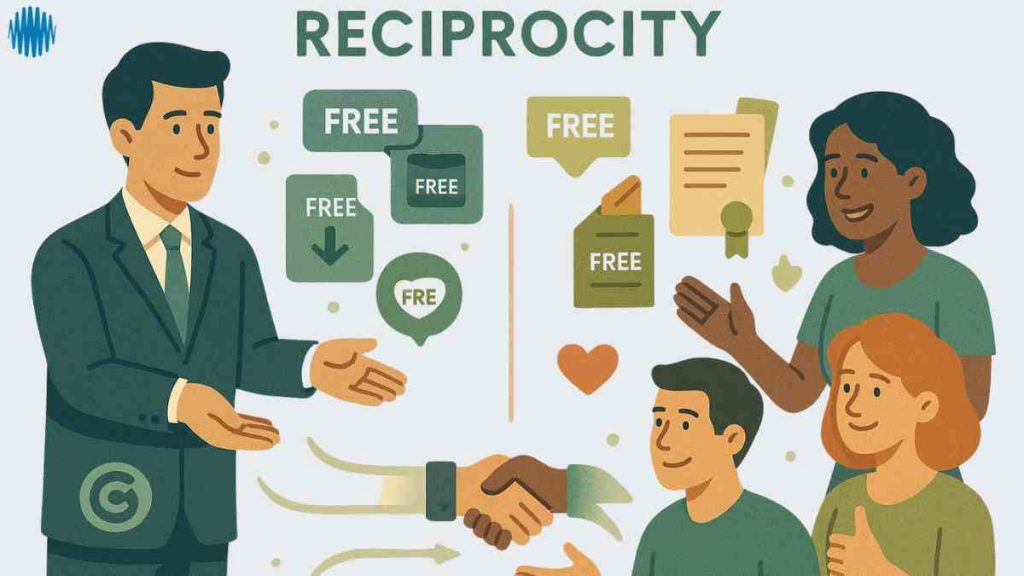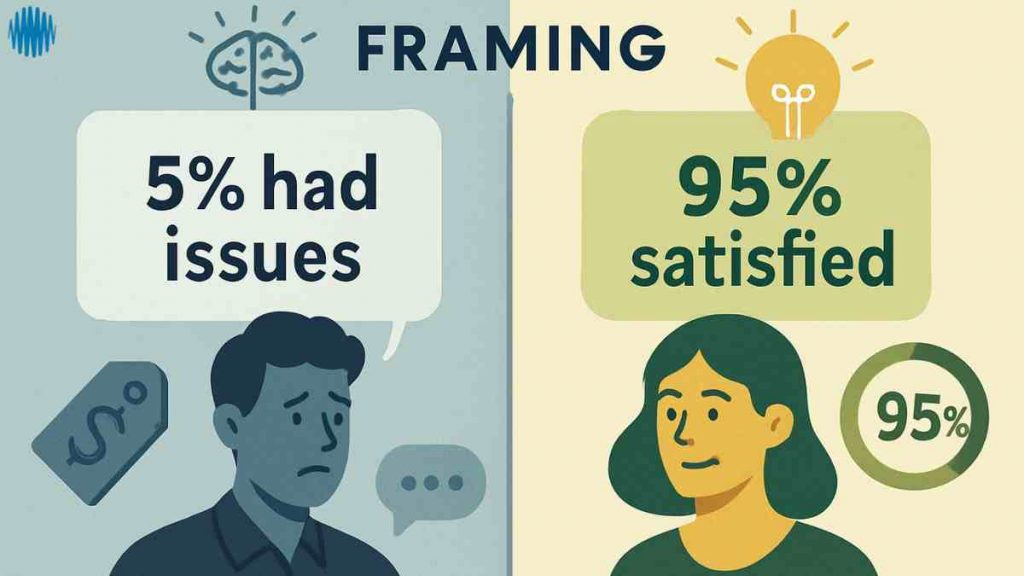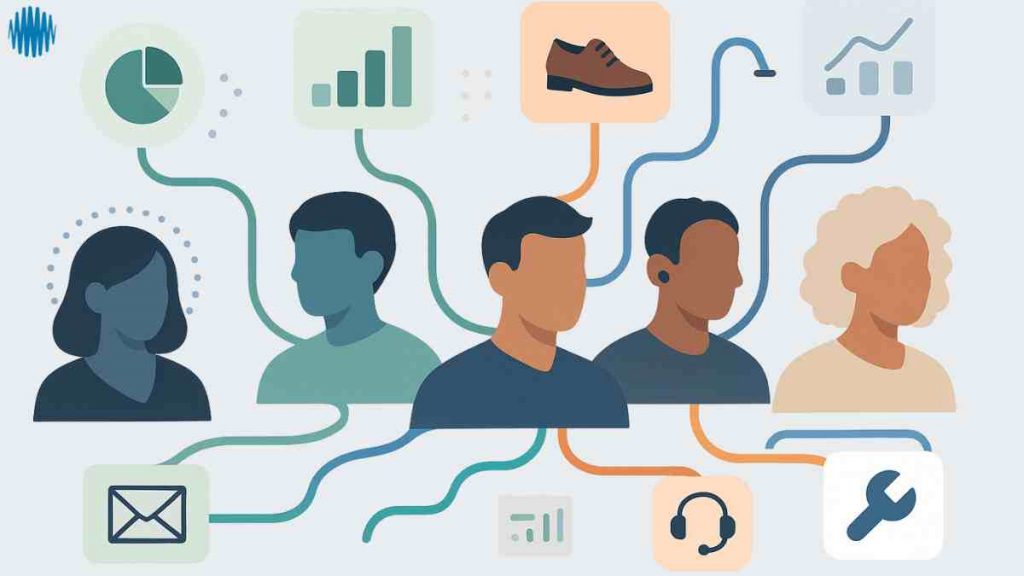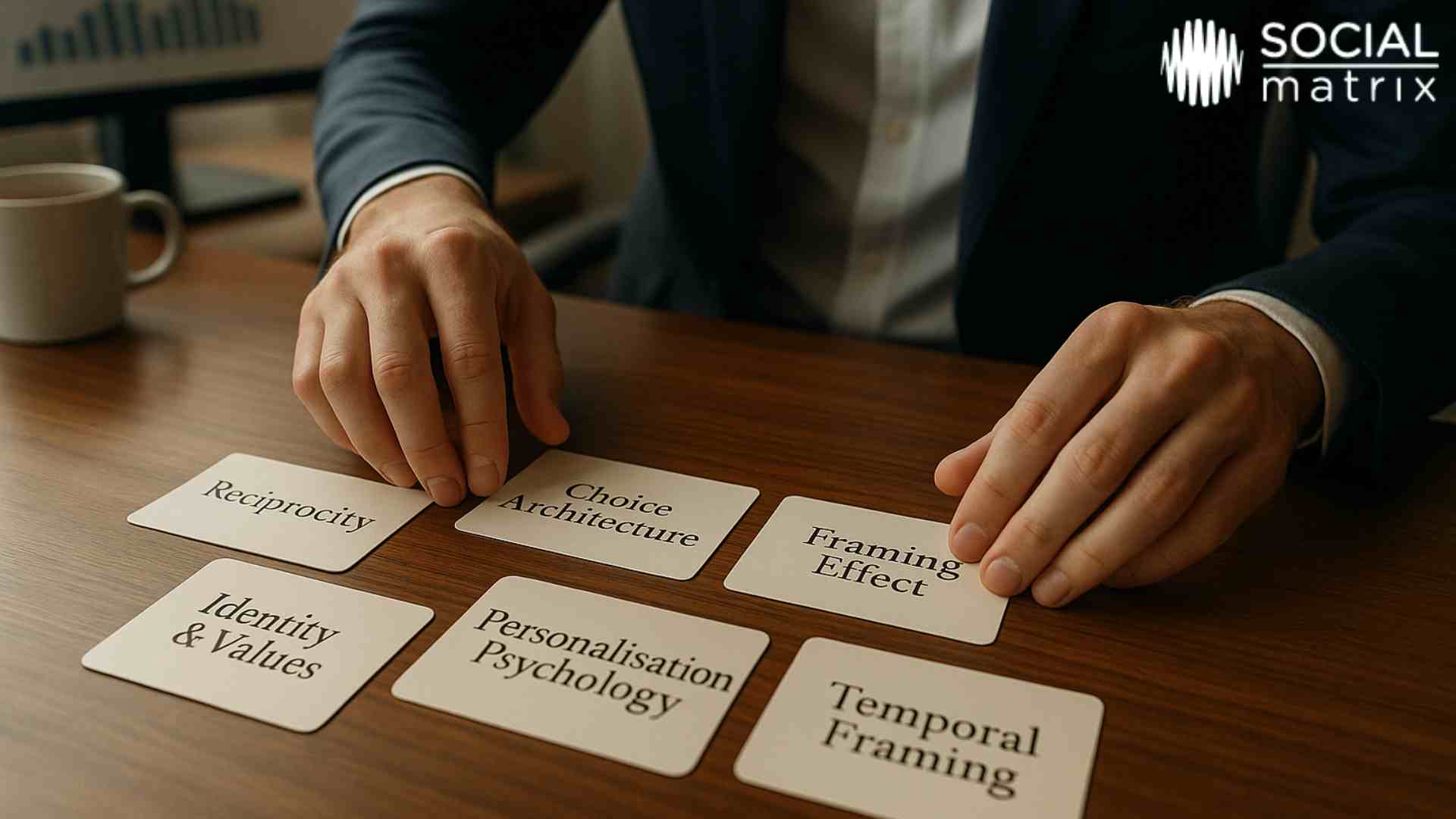If you’ve read our foundational guide to sales psychology, you’re already ahead of most small business owners. You understand how emotions drive decisions, how social proof builds trust, and how scarcity can create urgency.
But maybe you’ve noticed that some businesses go further. They seem to effortlessly create devoted customers who post about them on social media and constantly refer people. Their customers come back, engage, and become genuine fans. And it’s not always because the product is better.
What’s their secret?
The answer lies in deeper layers of sales psychology.
In this article, we’ll walk you through six advanced sales psychology techniques that help people feel more connected to your brand and more confident about buying from you. Nothing complicated, just smart ways to build stronger relationships and make your marketing work better.
Reciprocity: Why Giving First Builds Trust
People are naturally wired to return favours. When someone gives us something helpful – like a free sample, useful advice, or even just their time – we feel a natural urge to give something back. This principle of reciprocity has been studied for decades and is a cornerstone of trust-building in marketing.
Why It Works: When your business provides value without asking for anything upfront, you show customers you care about their needs, not just the sale. This builds goodwill and lowers resistance. In fact, studies show that reciprocity-based marketing can boost engagement by 30% and improve conversion rates by 20%.
For example, a local gym could offer a free 7-day meal plan that helps people start healthier habits before they’ve even signed up. A financial advisor might share a simple retirement planning checklist. These resources don’t ask for anything in return. They build trust by being genuinely helpful.
How to Use It in Your Business:
- Share helpful tools, guides, or tips through your website or emails
- Offer a free sample, trial, or short consultation with no strings attached
- Send tailored advice based on what a customer has asked about
- Give early access to new products or bonuses to your email list
- Provide templates, calculators, or checklists customers can use straight away
Helpful Reminders:
- Do focus on real value – something your audience can use immediately
- Do follow up with more help, not a sales pitch
- Don’t disguise promotions as “free” help – people can tell the difference
- Don’t expect instant results – reciprocity takes time to build trust
What to Measure:
- Downloads and time spent on your free resources
- Conversion rates from trial to paid users
- Lifetime value of customers who started with a free offer
- How often these customers refer others

Choice Architecture: Guide Decisions Without Overwhelming Customers
The way you structure and present choices affects how people decide. When faced with too many options, customers often freeze and leave without buying. This happens because choosing takes mental effort, and too many choices can lead to decision fatigue.
Why It Works: People are more likely to act when the decision framework is clear and manageable. You’re not limiting what’s available. You’re organizing it in a way that reduces cognitive load. When customers can easily compare options and understand the differences, they feel more confident moving forward.
A restaurant with 15 main courses scattered across one long menu might reorganise them into clear categories: “Light Bites” (5 options), “Hearty Classics” (6 options), and “Chef’s Specials” (4 options). Same food, but the structure makes choosing feel manageable rather than overwhelming.
How to Use It in Your Business:
- Group related services or products into clear categories (maximum 3-5 per category)
- Use visual hierarchy to show the relationship between different options
- Create comparison tables that highlight key differences at a glance
- Remove or combine similar options that create unnecessary complexity
- Design your website navigation and product pages to guide people step-by-step
Helpful Reminders:
- Do test different ways of organising your offerings to see what reduces confusion
- Do use clear headings and visual cues to separate different choice categories
- Don’t assume more options automatically mean more sales – often the opposite is true
- Don’t bury important differences between options in long descriptions
- Don’t create artificial categories that don’t help customers understand their choices
What to Measure:
- Time spent browsing vs. time spent deciding
- Drop-off rates at different stages of your sales process
- Customer feedback about ease of choosing
- Conversion rates before and after restructuring your offerings
Framing Effect: How You Say It Changes How People Feel
The way you present information can completely change how it’s received, even if the facts stay the same. This is a powerful sales psychology principle called the framing effect. Our brains react differently depending on whether something sounds positive or negative, even when both versions are technically accurate.
Why It Works: We don’t make decisions purely based on logic. We respond to how things make us feel. A product framed around positive results (“95% of customers are happy”) feels much more reassuring than one framed around problems (“5% had issues”), even though both are true. Good framing helps people feel confident and ready to take action.
Instead of saying “We’ll get back to you within 7 days,” a local service provider could say, “You’ll hear from us within one week.” It’s the same timeframe, but it feels quicker and more responsive.
How to Use It in Your Business:
- Use benefit-focused language that highlights gains, not just problems
- Frame prices in a way that feels manageable, e.g. “Only £2.50 a week” instead of “£130 a year”
- Present stats and success rates in the most encouraging, transparent way
- Choose words that reflect the feeling you want customers to associate with your service
- Turn objections into reassurance by changing the angle of your message
Helpful Reminders:
- Do A/B test different versions of your headlines or pricing displays
- Do be specific – “Save 3 hours a week” feels more real than “Save time”
- Don’t exaggerate – claims like “999% improvement” can damage trust
- Don’t ignore your audience – what works for a luxury brand might feel out of touch for a budget-friendly offer
- Don’t use positive framing to cover up flaws – transparency always wins
What to Measure:
- Conversion rates for different versions of the same message
- How people respond in feedback or reviews – do they seem confident or hesitant
- Drop-off rates from sales or sign-up pages
- Whether framed offers reduce price objections or hesitation

Identity and Values: Helping Customers See Themselves in Your Brand
People don’t just buy products to solve problems. They buy things that help them express who they are or who they want to become. Every purchase is a small act of identity reinforcement. When customers see your product or service as an extension of their values or self-image, price becomes less important than personal alignment.
Why It Works: Customers are drawn to brands that feel like a natural fit. If your message, tone, and visuals reflect the world your customers live in, or the one they aspire to, it builds instant trust. They’re more likely to choose you, stick around, and tell others about their experience.
A yoga studio that says, “Where self-care isn’t selfish – it’s essential” speaks to parents who value being their best selves for their families but struggle with guilt about taking time for themselves. A local coffee shop saying, “Supporting local farmers, one cup at a time” instantly connects with customers who see their purchasing choices as a way to make a positive impact.
How to Use It in Your Business:
- Identify what values matter most to your ideal customers, then weave those into your messaging
- Create products or services that help customers become the person they want to be
- Use language that speaks to aspirational identity: “For the entrepreneur who values quality” or “Made for the mindful parent”
- Share stories about customers who embody the values you support
- Position your business as a way for customers to vote with their wallet for what they believe in
Helpful Reminders:
- Do research what your customers actually care about through surveys and conversations
- Do be authentic – customers can tell when values-based messaging isn’t genuine
- Don’t assume everyone in your market shares the same values
- Don’t change your values messaging based on trends – consistency builds trust
- Don’t make it about you – make it about how customers can express themselves
What to Measure:
- Customer testimonials that mention values alignment
- Social media engagement when you post about values-based topics
- Customer lifetime value – people who connect with your values tend to stay longer
- Word-of-mouth referrals – identity-aligned customers become advocates
Personalisation Psychology: Making Every Customer Feel Seen
While identity marketing speaks to shared values, personalisation responds to individual behaviour. When someone browses specific products, asks particular questions, or makes certain purchases, they’re revealing their immediate needs. This sales psychology technique uses these behavioural signals to create more relevant experiences.
Why It Works: People pay more attention to messages that feel directly relevant to their recent actions. Someone exploring beginner-level products needs different information than someone who’s been buying advanced products for years. This behavioural relevance feels helpful rather than generic.
Your booking data might show that customers who book Tuesday appointments are usually working parents squeezing sessions into their lunch break. You could create a “Midweek Express” service that acknowledges this reality – same service, but framed and timed for their specific situation.
How to Use It in Your Business:
- Send different follow-up emails based on what someone actually purchased or enquired about
- Create website experiences that change based on previous visits or actions
- Offer relevant add-ons based on specific purchase patterns, not broad assumptions
- Use past behaviour to predict timing – when someone might need to reorder or book again
- Segment your communications based on engagement level, not just demographics
Helpful Reminders:
- Do start simple – track obvious behaviours like first-time vs. repeat customers
- Do use behavioural data to be more helpful, not more pushy
- Don’t assume one action defines someone – they might have been buying a gift
- Don’t overdo it – mentioning specific page views can feel intrusive
- Don’t ignore context – someone’s needs change over time
What to Measure:
- Response rates to behaviour-triggered emails or offers
- Repeat purchase rates when you acknowledge past buying patterns
- Customer feedback about message relevance
- Conversion rates for behaviourally-targeted content vs. generic messages

Temporal Framing: Help Customers Feel Good About Buying Now and Later
Every buying decision involves a bit of back-and-forth. Some people want instant results. Others care more about long-term value. Most customers consider both, even if they’re not fully aware of it. If your offer only speaks to one side, they may hesitate. This sales psychology principle addresses both timeframes.
Why It Works: When you show customers that your product or service delivers now and continues to deliver over time, it’s easier for them to justify the purchase. Short-term wins ease urgency. Long-term value builds confidence. Together, they reduce doubt and help customers move forward.
A skincare brand might promise an “Instant glow after first use” and add “Reduces fine lines over 12 weeks.” A kitchen appliance shop could say “Saves 30 minutes per meal” and “Cuts £200 a year off your energy bills.” A business coach might offer “Quick wins to boost confidence in the first month” alongside “A roadmap for long-term growth.”
How to Use It in Your Business:
- Pair immediate results with long-term benefits in your descriptions and offers
- Use clear timeframes, such as “in 24 hours,” “within 2 weeks,” or “over the next year”
- Combine fast delivery or onboarding with follow-up support or extended guarantees
- Address both the urgency of now and the value of the future in your copy
- Test different combinations to see what resonates most with your audience
Helpful Reminders:
- Do understand what your audience values – speed, stability, or both
- Do use specific, believable timeframes – customers want to know what to expect
- Don’t make vague promises like “soon” or “quickly” – they create uncertainty
- Don’t ignore future-focused buyers by focusing only on quick results
- Don’t overpromise fast outcomes – disappointment damages trust
What to Measure:
- Purchase timing: Do customers buy faster when you highlight quick wins?
- Customer lifetime value: Are long-term benefits helping you retain buyers?
- Feedback and reviews: Are people satisfied with the timeline of results?
- A/B test performance: Compare different time-based phrases and offers
Why Sales Psychology Matters for Your Business
Good marketing doesn’t mean pushing harder. It means understanding what makes people buy and removing the things that stop them.
These six sales psychology triggers give you practical ways to do exactly that. They help you build trust, reduce hesitation, and make it easier for customers to say “yes.”
You don’t need to use every tactic at once. Start small, experiment, and see what resonates. Even one or two changes can turn more browsers into buyers and first-time customers into loyal fans.
And if you’d like support applying these sales psychology techniques to your website or marketing, get in touch. At Social Matrix, we help small businesses create marketing that actually connects with people and drives results.

